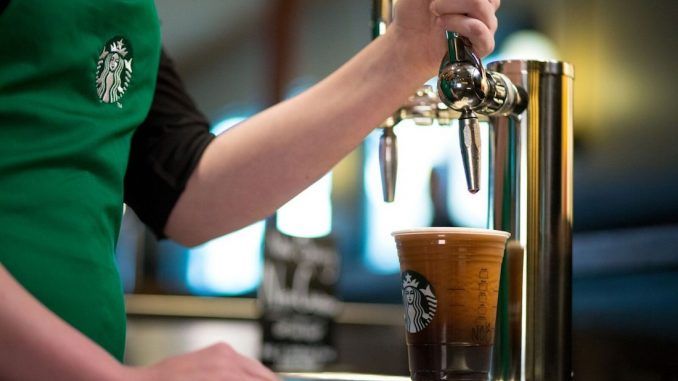
Starbucks spends millions in advertising to convince customers they are an environmentally friendly and ethical corporation, but it has been discovered that the coffee giant is in bed with Monsanto and has spent over $100 million to cover up this fact from consumers.
We live in an age of inequality and social divide. With 1% of the population in the United States holding 38% of the wealth and almost all of the power. Education, healthcare, the government, and even the food we eat and drink are owned by wealthy individuals and faceless corporations.
So it may not come as a surprise to you that a morning coffee from Starbucks is the last thing that you should be drinking to put a pep in your step.

BYPASS THE CENSORS
Sign up to get unfiltered news delivered straight to your inbox.
You can unsubscribe any time. By subscribing you agree to our Terms of Use
It has been discovered that the coffee conglomerate has spent nearly $100 million to cover up their use of GMOs in their drinks.
Starbucks and GMO foods
‘In the past two years alone, Starbucks has been a part of a GMA-led coalition that has donated more than $70 million dollars to defeat GMO labeling efforts in California and Washington State,’ said a spokesperson for Food Democracy Now. ‘By opposing GMO labeling, Starbucks has willingly climbed in bed with Monsanto and the GMA and is intentionally misleading customers about their commitment to sustainability and ethical sourcing.’
The Hearty Soul reports: It’s a damning statement and is certainly warranted. Not only have Starbucks been putting on a facade as an ethical organization, but they have proactively sought to increase the usage of GMO foods. Considering that they have over 23,000 stores in 64 different countries, Starbucks has a huge influence on farmers.
Starbucks’ milk currently comes from factory farmed cows, usually owned by their partner Monsanto. These cows are kept in terrible conditions, pumped with unnatural antibiotics and fed GMO grains. According to the Organic Consumers Association (OCA) in 2011, Starbucks used over, ‘93 million gallons of milk per year, enough to fill 155 Olympic-sized swimming pools.’
Considering their continued growth over the past five years it is likely that the figure today would be even higher. Their continued desire to quash legislation that calls for the labeling of GMO foods equates to an awful lot of people consuming them without their prior knowledge.
Starbucks and GMA
As Food Democracy Now stated, Starbucks is part of a collection of 300 of the world’s largest food companies called Grocery Manufacturers Association (GMA). GMA’s role is to lobby governments in order to prevent ethical legislation being passed that might cut into their member’s profit margin.
For a company like Starbucks GMA is the perfect cover up. On the surface, they can still appear to support sustainable produce, whilst pumping ludicrous sums of money into protecting their bottom line.
Most recently the group has been attempting to prevent GMO foods being labeled as GMO to consumers in California and Washington. Two years ago they failed to prevent Vermont passing the first measure of this kind, which came into law in July of this year. Act 120 now ensures that all GMO products or ingredients must be clearly labeled, in order for the consumer to make their own decision to use the product. Since the bill passed, early indications suggest that GMO foods sales have decreased significantly.
Although Vermont is a much-needed success story, Monsanto, Starbucks and the GMA have, thus far, successfully prevented the passing of similar acts in 30 other states, at an expense far exceeding $100 million. Big business and big cheques are undermining the very fabric of democracy.
No matter how small each of us feels in the face of such an abhorrent misuse of power, we can all make a real difference. Turn your back on businesses like Starbucks who have been shown not to care about the rest of us. The rights of the 99% are the only reason we should need.
Dangers of Common Ingredients
Sugar Addiction
Our diets should only have about 6-9 teaspoons of sugar every day; this is about 24-36 grams, half the amount in a Unicorn Frappuccino. The health risk of consuming too much sugar is overwhelming. Diets with too much sugar see a greater risk of:
- Weight gain
- Cavities
- Rise in blood pressure
- Heart disease
- Death
Watch this Dr.Axe video which shares even more about the dangers of sugar:
Too Much Salt
Salt fills the American diet — this is a concern for the elderly, those with high blood pressure, and people with diabetes.
Salt also causes trouble for your kidneys which must deal with extra sodium in the bloodstream.
Our blood vessels also have trouble with extra salt as more water fills our veins to dilute the sodium in our blood, putting pressure on our circulatory system which can lead to a heart attack or stroke.
Potassium Sorbate
The Unicorn Frappuccino is filled with ingredients that contain Potassium sorbate, a preservative that stops bacteria, fungi, mold, and yeast. Large quantities can lead to allergic reactions leading to symptoms like itchy mouth, throat, eyes, and skin, as well as congestion, runny nose, and abdominal pain.
Potassium sorbate can also lead to migraines which can result in other problems like nausea, vomiting, and sensitivity to light.
Juice Concentrate
This is processed fruit juice which has an increased shelf life and is made because it can be shipped easier. However, nutrients are lost in the process as the fresh juice is extracted through evaporation and filtration techniques.
Like most juice, it is also high in sugar which can be an issue for your pancreas, and for diabetics. Additionally, if these juices are sweetened with high-fructose corn syrup it may increase your chances of diabetes, and acid reflux disease while irritating ulcers.
Dextrose
Dextrose is made from starchy vegetables and turned into monosaccharides which are essentially sugars. Is dextrose bad for you? The answer is yes: This sugar is pure energy which often can’t be used quick enough by the body and is turned into fat as a result. Dextrose has many of the same effects as sugar and is associated with heart disease, diabetes, stroke, cancer, and Alzheimer’s disease.
Since dextrose is a product of GM corn people who eat these products may putting themselves at risk. Dr. Mercola worries that when you eat GM corn and products containing the GM product you are allowing it to cause problems with your health as it sits in your gut and affects the good and bad bacteria in your digestive tract.
Worst Starbucks Drinks To Avoid: Other Calorie Filled Drinks
Other than the unicorn frappuccino, there are many other sugary and unhealthy drinks at Starbucks you may want to avoid such as:
- Double Chocolatey Chip Cream Frappuccino – for a grande cup, you’re adding 420 calories to your diet. This drink includes milk, whipped cream, frappuccino syrup, mocha chips, and mocha sauce (this contains corn syrup, high fructose corn syrup, sugar, cocoa, potassium sorbate).
- Strawberries and Cream Frappuccino – for a grande cup, you’re adding 370 calories to your diet. This drink includes milk, cream frappuccino syrup, strawberry base, whipped cream, and the classic syrup (this contains sugar, water, citric acid and potassium sorbate).
- Java Chip Frappuccino – for a grande cup, you’re adding 470 calories to your diet. This drink includes milk, coffee frappuccino syrup, whipped cream, mocha sauce and frappuccino chips.
- White Chocolate Mocha Frappuccino – for a grande cup, you’re adding 520 calories to your diet. This drink includes milk, coffee frappuccino syrup, coffee, whipped cream and white chocolate mocha sauce.
- Caramel Coco Cluster Frappuccino – for a grande cup, you’re adding 450 calories to your diet. This drink includes milk, coffee frappuccino syrup, whipped cream, coffee, caramel sauce and mocha sauce.
Sometimes you can’t help but crave that creamy taste of a nice ice-cold frappuccino. If this is the case, order a “light”, no whip frappuccino instead. You’ll experience the same taste, the only difference is that they use sugar-free syrup as oppose to the regular ones and nonfat milk instead of regular milk. The Caramel Light Frappuccino is a great example of this; a grande cup is 140 calories, definitely much lower than the others ones mentioned above.
Best Starbucks Drinks Under 150 Calories (Tall)
Instead of drinking sugary, fattening drinks filled with calories, try these tasty alternatives instead:
- Caffe Americano (you can also get this iced) (11 calories) – made with a shot of espresso and topped with hot water.
- Caffe Misto with Soy (63 calories) – a combination of brewed coffee and steamed soy milk. You can substitute this for almond milk as well.
- Cappuccino (91 calories) – an espresso, heated with soy milk.
- Teavana Shaken Black Iced Tea (30 calories) – just tea which means you can afford to lightly sweeten it with sugar.
- Teavana Sparkling Berry Sangria Herbal Tea (120 calories)- if you know you want to splurge on a Starbucks drink, opt for this, one of many alternatives that is better than those fattening frappuccinos.
Ordering these drinks also saves this one barista, who wasn’t very happy, from making this unicorn frappuccino repeatedly. As supplies finally run out, this crazy obsession with unicorns will fade away, but until then, baristas all around the nation will have to continue to make and serve this frappuccino to its sugar-addicted customers.


